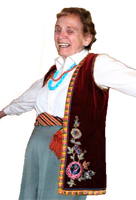
|
The Society of Folk Dance Historians (SFDH)
A Typical Evening of Dancing By Faith Schottenfeld Zavon, February 2, 2003
[
Home |
About |
Encyclopedia | CLICK AN IMAGE TO ENLARGE |

|
Faith Schottenfeld Zavon of Cincinnati, Ohio, was born on September 13, 1923 and passed on September 18, 2021 at the age of 98. She was a prolific writer. Faith was born in Brooklyn and graduated with a BA in science from Brooklyn College. She married and raised four children, working over the years as a food chemist, a bacteriologist, a court reporter, and a legal secretary. She also taught a course in logic at the University of Cincinnati. Faith was a friend of the Society of Folk Dance Historians founder, Ron Houston.
Here is one of her folk dance essays.
It started at 8:00 p.m. every Friday night. The hall filled up rapidly. By the first dance it was usually quite crowded and became more so later on. The first dance was always a simple one in which you change partners, such as Jibidi Jibida or Chimes of Dunkirk.
Then followed European couple dances and Balkan line dances which Michael (we called him Mike) taught. His method of teaching was to show the dance first. He usually danced it with Anna who seemed to me to be of Slavic background and a good friend of the Hermans. She knew the dances, but didn't dance often. Instead she stood at the front of the room near the stage (not on it) while the dancing was going on, always clapping OFF the beat in time to the music. After he demonstrated the dance he taught it. Then the music was put on and we danced it.
Interspersed among the dances that were taught he would have what he called "free" dances. He shouted "Free Waltz" and we knew it would be a waltz without figures, just waltzing. You would get another partner for this and do it in any style you wanted. In this manner we also had "free" polkas and schottisches. This kept everything and everyone moving. Sometimes he would shout, "Hambo for those who know it." Hambos were also interspersed between the dances he taught. He always had MANY different kinds of dances in the evening, which made for exhilaration (at the juxtaposition of so many different kinds of movement and music), wonderment and surprise (at not knowing what was coming next), and opportunity to dance with a different person for each dance instead of staying with one partner.
Along about 10:00 p.m. they played the more intricate dances, such as Hopak, Kolomyjka Sianka, etc. By that time the teaching part of the evening was over, but the "free" dances and hambos and requests went on until 11:00 p.m. when the dance was over. The last dance was always a waltz. In my mind I can still hear Michael's voice shouting, "Last Waltz!"
This page © 2018 by Ron Houston.
Please do not copy any part of this page without including this copyright notice.
Please do not copy small portions out of context.
Please do not copy large portions without permission from Ron Houston.